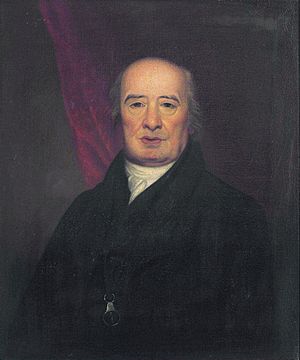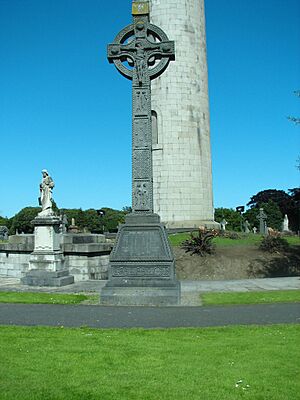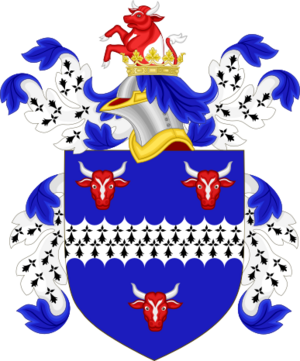Thomas Addis Emmet facts for kids
Quick facts for kids
Thomas Addis Emmet
|
|
|---|---|

Portrait by Samuel F. B. Morse, c. 1820
|
|
| Attorney General of New York | |
| In office 1812–1813 |
|
| Preceded by | Matthias B. Hildreth |
| Succeeded by | Abraham Van Vechten |
| Constituency | New York County, New York |
| Personal details | |
| Born | 24 April 1764 Cork, Ireland |
| Died | 14 November 1827 (aged 63) |
| Political party | Democratic-Republican |
| Other political affiliations |
|
| Spouse |
Jane Patten
(after 1791) |
| Relations | Christopher Emmet (brother) Robert Emmet (brother) Mary Anne Holmes (sister) |
| Alma mater | Trinity College Dublin University of Edinburgh |
Thomas Addis Emmet (born April 24, 1764 – died November 14, 1827) was an important lawyer and politician. He was from Ireland and later lived in America.
In the 1790s, in Ireland, he was a key member of the Society of United Irishmen. This group planned to rise up against the British government and the unfair rules that favored Protestants.
After moving to America, he became a successful lawyer in New York. He was known for strongly supporting the end of slavery. From 1812 to 1813, he served as New York's top lawyer, the Attorney General.
Contents
Thomas Addis Emmet's Early Life
Thomas Addis Emmet was born in Cork, Ireland, on April 24, 1764. His father, Dr. Robert Emmet, became a well-known doctor in Ireland. His mother was Elizabeth Mason.
He was the older brother of Robert Emmet, who became a famous Irish hero. Robert was executed for leading a rebellion in 1803. Thomas's sister, Mary Anne Holmes, also shared their strong political beliefs.
Thomas went to Trinity College, Dublin and later studied medicine at the University of Edinburgh. However, his older brother Christopher died suddenly. This led Thomas to change his path and study law instead.
Fighting for Change in Ireland
Thomas Emmet believed strongly in fairness and equal rights. He joined the fight to give more people the right to vote in Ireland. He also worked to end unfair laws against Catholics.
In 1790, he became a lawyer in Ireland. He often defended people accused of political crimes. He also became the main legal advisor for the Society of the United Irishmen.
This group wanted to make Ireland a republic, free from British rule. They also wanted to end unfair religious laws. Thomas Emmet helped write their important statement in 1792.
In 1795, he officially joined the United Irishmen and became a leader. By this time, the group was banned and had to meet in secret. They started planning a rebellion, hoping for help from France.
British spies found out about the plans. Many United Irishmen leaders were arrested in March 1798. Thomas Emmet was also arrested around this time.
He was held in prisons in Ireland and then in Scotland until 1802. After his release, he went to Brussels. There, his brother Robert told him about new plans for a rebellion in Ireland.
However, France and Britain were at peace then, so Napoleon did not help. Thomas heard about his brother Robert's failed rebellion in 1803 while in Paris.
He became disappointed with Napoleon's new empire. He believed that if France invaded Ireland, it would just make Ireland another controlled state. So, in October 1804, he sailed with his family to America.
He wrote to a friend that France had become a place of "fraud, deceit, [and] despotism." He felt that no nation that loved freedom should expect honest help from France.
A New Life in America
When Thomas Emmet arrived in America, he chose to settle in New York City. He refused to live in the American South because he strongly opposed slavery.
He quickly started a legal practice. He became involved with the abolitionist Society of Friends (the Quakers), who worked to end slavery.
In his very first case, he defended a person who had escaped slavery. In 1805, he won an important case against a ship captain. This case helped the New York Manumission Society, which worked to free enslaved people.
Thomas Emmet continued to help this society without pay until he died in 1827. He gave them legal advice and represented them in court.
A Champion for Freedom
In August 1812, Thomas Emmet was appointed New York State Attorney General. This meant he was the state's top lawyer. He was part of the Democratic-Republican Party.
However, he was removed from office in February 1813. This happened when the Federalist Party gained more power. They had opposed him becoming a lawyer in New York in the first place.
Despite this, Thomas Emmet became one of the most respected lawyers in the United States. His skills and successes were widely praised.
A Supreme Court Justice named Joseph Story called him "the favourite counsellor of New York." Emmet argued important cases before the United States Supreme Court.
One famous case was Gibbons v. Ogden in 1824. This case was about trade rules between states and the power of the U.S. Constitution.
Family and Legacy

Thomas Emmet married Jane Patten in 1791. They had several children together:
- Robert Emmet, who became a well-known judge and Irish American activist in New York.
- Elizabeth Emmet (1794–1878).
- Margaret Emmet (1794–1883).
- John Patten Emmet (1795–1842).
- Thomas Addis Emmet (1797–1863).
- Jane Erin Emmet (1802–1890).
A famous artist, Samuel F. B. Morse, painted a portrait of Thomas Emmet around 1820. This painting is now very valuable.
Thomas Emmet died on November 14, 1827, while working on a case in court. He was first buried in New York City.
A monument was built in his memory outside St. Paul's Church in New York City. It honors his life dedicated to liberty and helping others. It also mentions his role in fighting for the rights of African people.
Emmet's Descendants
Thomas Emmet's family continued to be important. His grandson, Robert Emmet, also became a prominent judge.
His great-granddaughters, Rosina Emmet Sherwood, Lydia Field Emmet, and Jane Emmet de Glehn, became famous American portrait artists. His great-grandson, Robert Temple Emmet, was a military hero.
Another great-great-grandson was the playwright Robert Emmet Sherwood. A direct descendant, Valentin Ribet, a human rights lawyer, sadly died in the 2015 Paris attacks.
Thomas Emmet's grandson, Dr. Thomas Addis Emmet, was a doctor and Irish American activist. He asked to be re-buried in Ireland. He wanted to "rest in the land from which my family came."
So, in 1922, Dr. Emmet was buried in Glasnevin Cemetery in Dublin. This cemetery is the final resting place for many Irish patriots.
An obelisk (a tall, pointed stone monument) stands in St. Paul's Chapel's graveyard in New York City. It honors Thomas Emmet's memory. It was put there by his friends and fellow activists.


